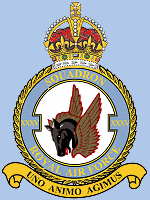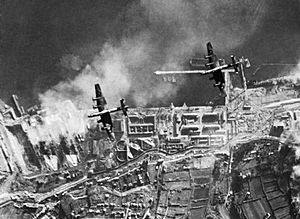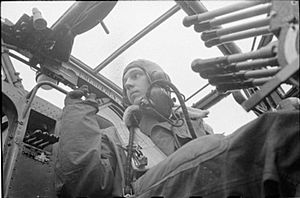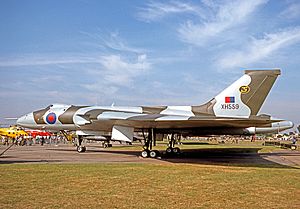No. 35 Squadron RAF facts for kids
Quick facts for kids No. XXXV (Madras Presidency) Squadron RAF |
|
|---|---|

XXXV Squadron badge
|
|
| Active | 1 February 1916 – 26 June 1919 1 March 1929 – 8 April 1940 5 November 1940 – 23 February 1950 1 September 1951 – 11 September 1961 1 December 1962 – 1 March 1982 |
| Country | |
| Branch | |
| Motto(s) | Latin: Uno animo agimus ("We act with one accord") |
| Battle honours | Western Front, 1917-18*: Arras: Lys: Ypres, 1917*: Cambrai, 1917*: Somme, 1918*: Amiens: Biscay Ports, 1941-43: Fortress Europe, 1941-44*: German Ports, 1943: Ruhr, 1943-45*: Normandy, 1944*: Baltic, 1944: France & Germany, 1944-45*: Walcheren.Honours marked with an asterisk are those emblazoned on the Squadron Standard |
| Squadron codes | WT Apr 1939 - Sep 1939 TL Nov 1940 - Feb 1951 FB Sep 1950 - Apr 1951 |
No. 35 Squadron, also known as No. XXXV (Madras Presidency) Squadron, was a special group of pilots and planes in the Royal Air Force (RAF). A squadron is a unit of military aircraft. This squadron played an important role in different conflicts, especially during the two World Wars.
Contents
History of No. 35 Squadron
World War I: Early Missions
No. 35 Squadron started on February 1, 1916, in Thetford, England. Their first job was to train as a "Corps reconnaissance squadron." This meant they would fly planes to scout enemy positions and gather information for the army.
In January 1917, the squadron moved to France. They flew Armstrong Whitworth F.K.8 planes. They began their missions during the Battle of Arras. They worked closely with the Cavalry Corps, which later inspired the winged horse in their squadron badge.
From August to October 1917, they were based at La Gorgue in Northern France. For a short time in 1918, they also used Bristol Fighters.
Supporting Ground Troops
The squadron helped the Fifth Army during the German Spring Offensive in March 1918. On March 21, the first day of the attack, they dropped 116 bombs on German troops. They continued to attack enemy soldiers from low altitudes. They also flew night bombing missions.
Later in 1918, the squadron supported III Corps during the Battle of Amiens. They also helped in the attack on the Hindenburg Line in September 1918.
By October 1918, the squadron began getting more Bristol Fighters. However, the war ended before they finished switching all their planes. The squadron returned to England in March 1919 and was officially closed on June 26, 1919.
Between the World Wars
No. 35 Squadron started up again on March 1, 1929, at RAF Bircham Newton. They first used Airco DH.9A planes. Later that year, they got Fairey IIIF aircraft. In 1932, these were replaced by an improved version called the Fairey Gordon.
In 1935, the squadron was sent to Sudan because of the Italian invasion of Ethiopia. They came back to RAF Worthy Down in August 1936. There, they started using Vickers Wellesley planes. On April 12, 1938, they switched to the Fairey Battle.
World War II: Training and Bombing Missions

When World War II began, No. 35 Squadron became a training unit. They used Avro Ansons and Bristol Blenheims in addition to their Fairey Battles. The squadron was closed on April 8, 1940, and its members joined another training unit.
The First Halifax Squadron
The squadron reformed on November 5, 1940. They became the very first squadron to use the Handley Page Halifax bomber. They received their first Halifaxes on November 13. They then moved to RAF Leeming and later to RAF Linton-on-Ouse in Yorkshire.
Their first mission with the Halifax was on the night of March 11-12, 1941. Six Halifaxes flew to bomb docks in Le Havre, France. The squadron continued to fly night bombing missions over France and Germany throughout 1941 and 1942. Famous pilots like Leonard Cheshire and James Brian Tait flew with No. 35 Squadron. Both later became highly decorated commanders of 617 Squadron.
Joining the Pathfinder Force
In August 1942, No. 35 Squadron was chosen to be one of the first five squadrons in the Pathfinder Force. This special force flew ahead of the main bomber groups to mark targets. The squadron was based at RAF Graveley. When the Pathfinder Force grew bigger, No. 35 Squadron became part of the new No. 8 Group. In March 1944, the squadron switched to the Avro Lancaster bomber, which they used until the end of the war.
Squadron Leader Alec Panton Cranswick, a pilot in 35 Squadron, flew many bombing missions during World War II. He completed 107 missions, more than any other RAF pilot in the war. He was shot down on July 4, 1944, during a raid near Paris.
After World War II
In 1946, the squadron took part in a victory flypast over London. They also went on a friendly tour of the United States. They later moved to RAF Stradishall. In September 1949, their Lancasters were replaced by Avro Lincoln planes. The squadron was closed again on February 23, 1950.
On September 1, 1951, the squadron reformed at RAF Marham. They were equipped with the Boeing Washington aircraft.
The Jet Age
In April 1954, the squadron got its first jet planes, the Canberra B.2 twin-engine light bomber. The squadron was closed once more on September 11, 1961.
No. 35 Squadron reformed for the last time on December 1, 1962, at RAF Coningsby. They became part of the RAF's V-bomber force, flying eight Vulcan B2 aircraft. These planes carried Yellow Sun nuclear bombs for high-altitude strategic bombing. They moved to RAF Cottesmore in November 1964. By mid-1966, they received WE.177B strategic bombs, which were designed for low-level attacks.
After the Royal Navy took over responsibility for nuclear weapons, the squadron joined the Near East Strike Force in RAF Akrotiri, Cyprus. They still had eight Vulcan B2s and eight WE.177 nuclear weapons, along with other conventional weapons. The squadron stayed in Cyprus until the end of 1974. They returned to RAF Scampton in January 1975. No. 35 Squadron was officially closed for the last time on March 1, 1982.
See also
- List of Royal Air Force aircraft squadrons



